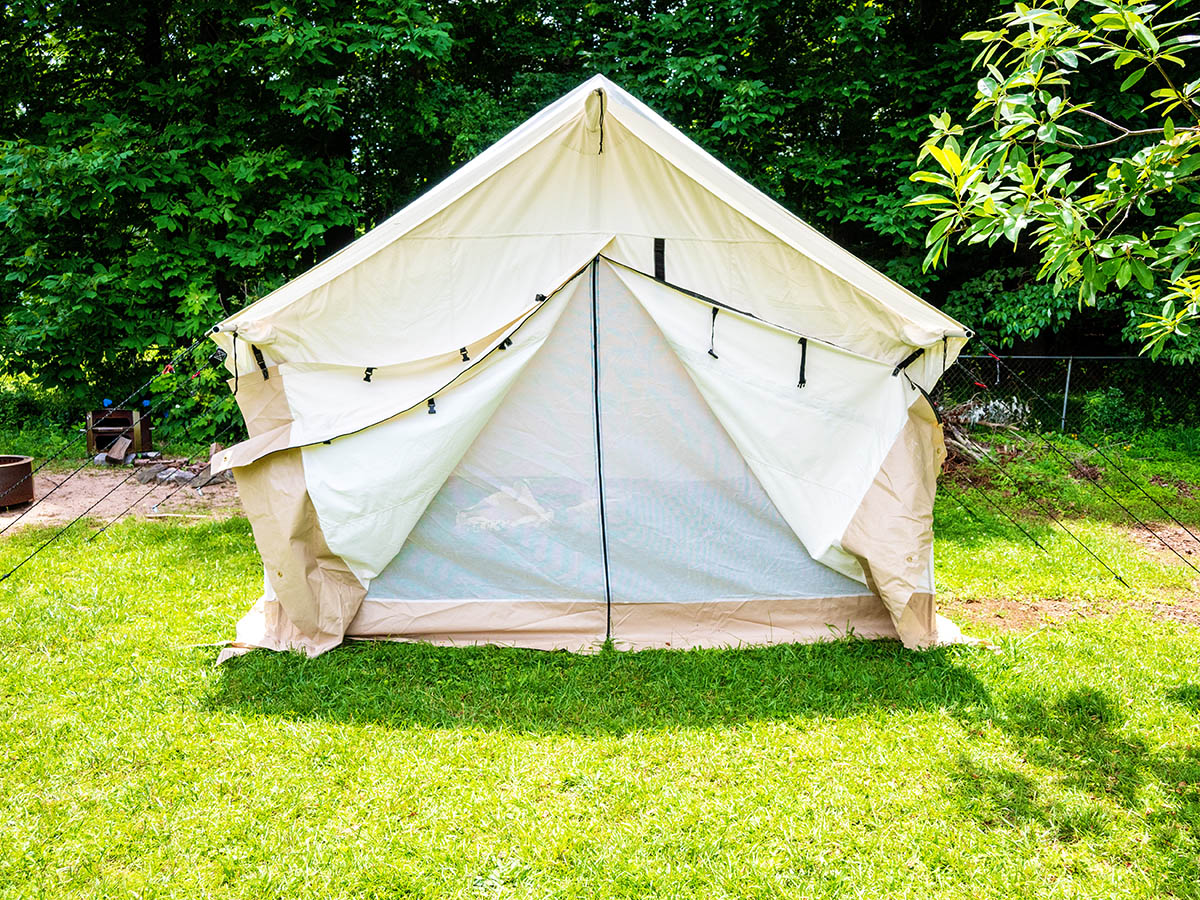We may earn revenue from the products available on this page and participate in affiliate programs. Learn More ›
As a product tester for a DIY and home improvement website, I was caught off guard by an offer to test the White Duck Alpha 10 x 12 Wall Tent. White Duck makes canvas tents, tarps, and gear for campers, hunters, and glampers—not exactly the outdoor power equipment and hand tools I normally review. At a glance, the Alpha Wall Tent is reminiscent of the tents I stayed in as a kid at summer camp. But it’s much roomier, includes bug screening, and accommodates a wood stove. I ended up using it all summer, and it turned out to be an ideal project shelter. In this Alpha Wall Tent review, I will share my thoughts on the overall quality and why I think it’s a good alternative to other long-term temporary shelters.
White Duck Alpha 10 x 12 Wall Tent: At a Glance
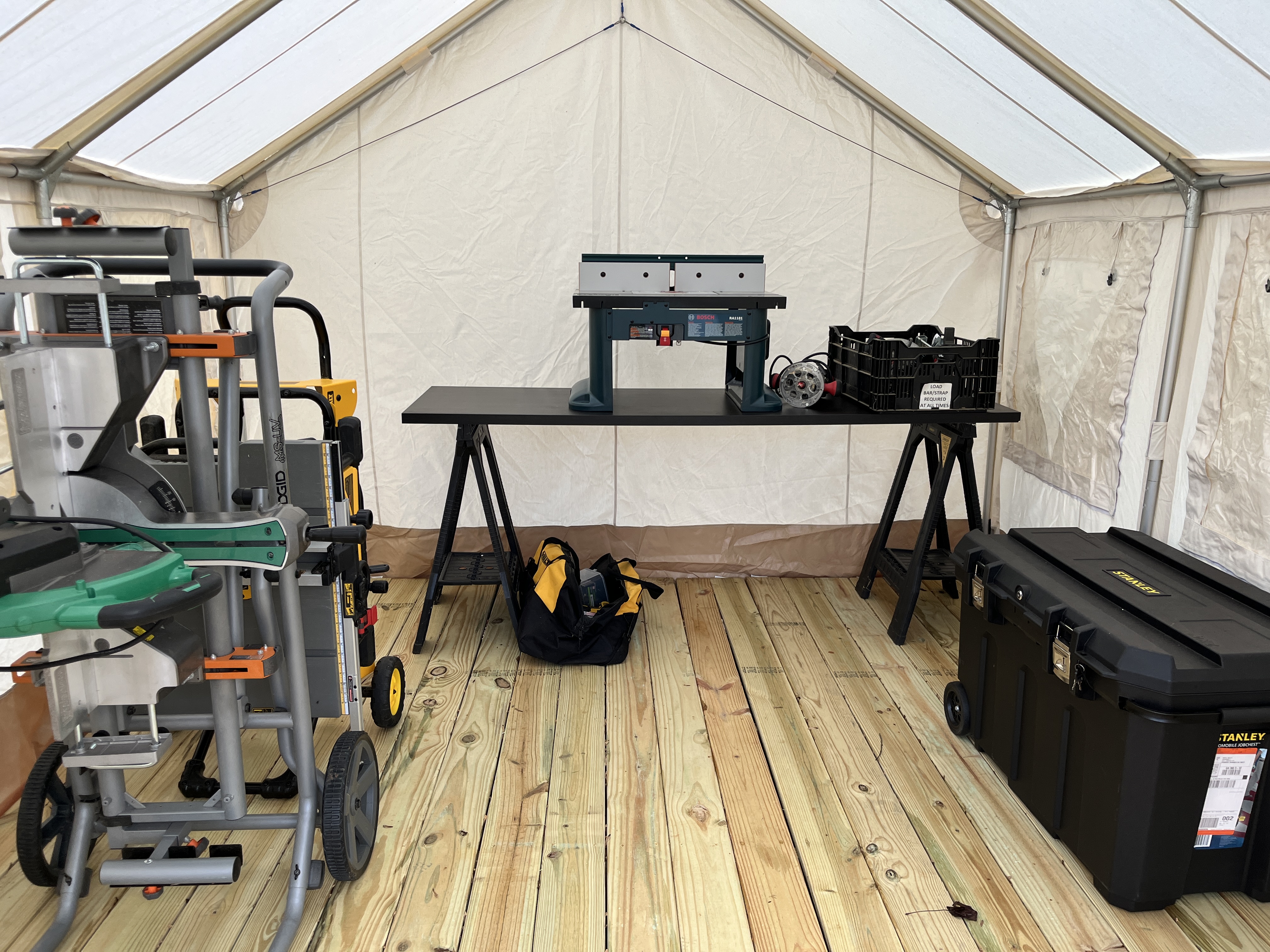
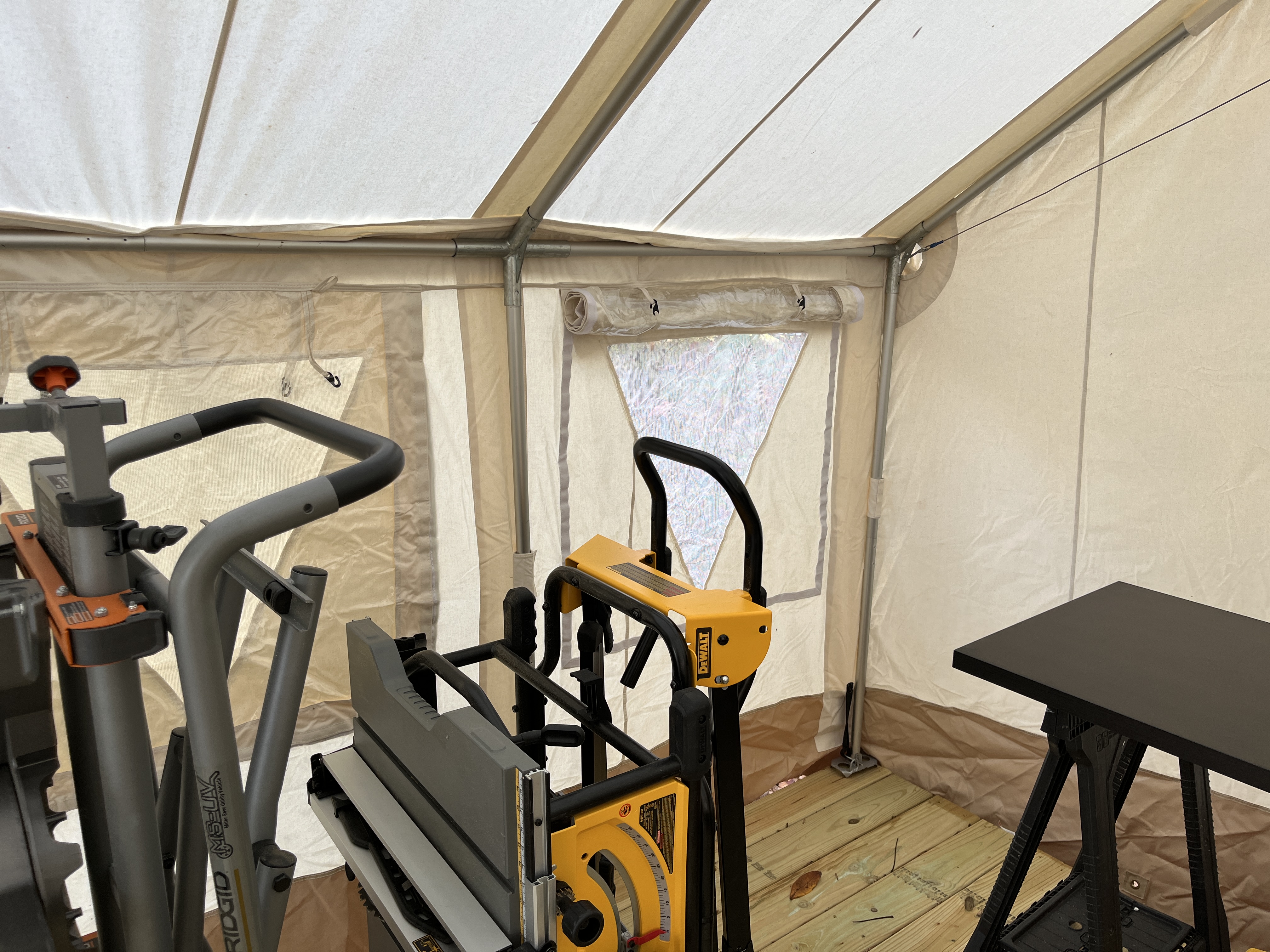
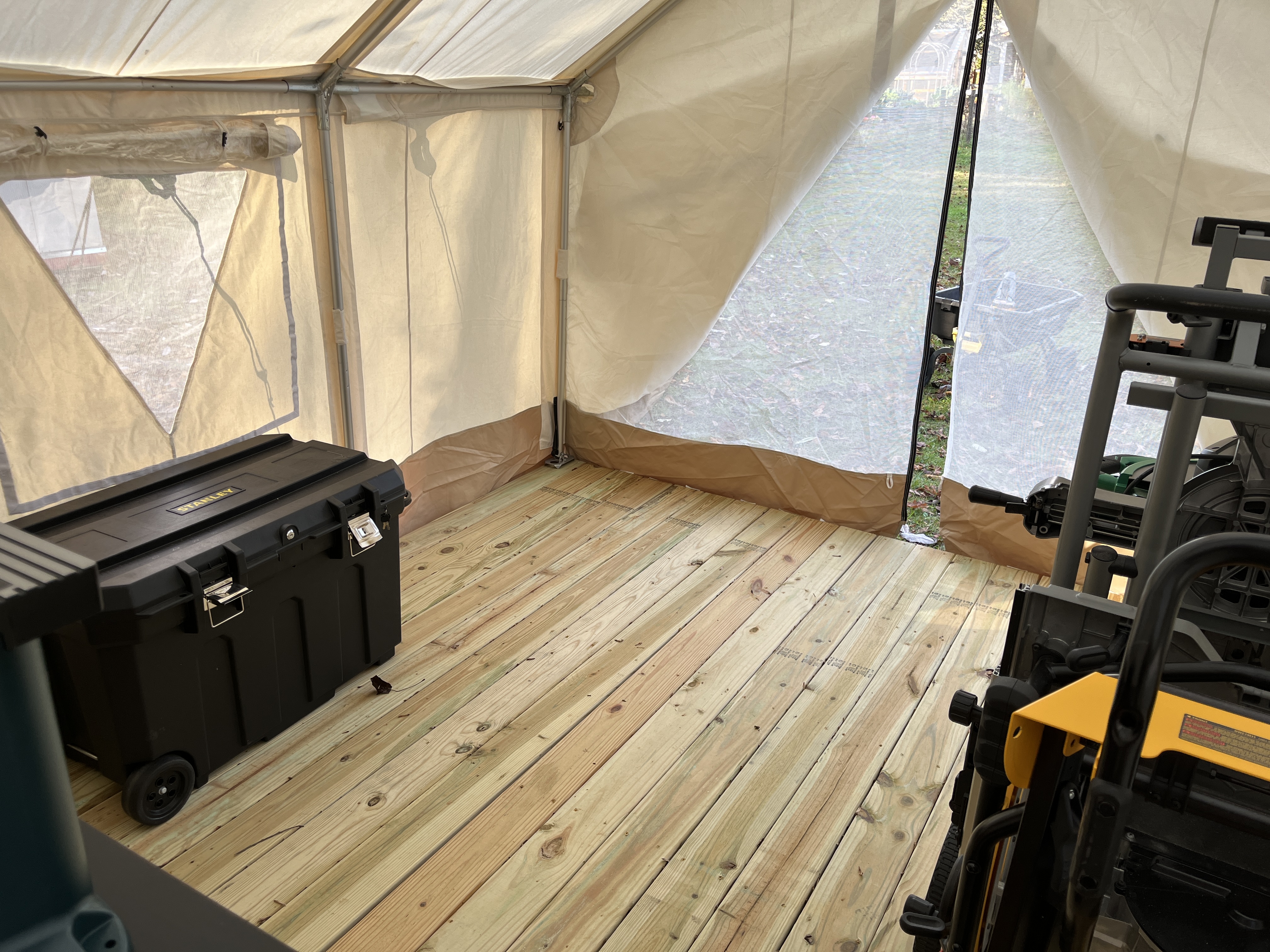
Our rating: 4.8/5
| White Duck Alpha 10 x 12 Wall Tent Specs | |
| Frame material | 1.181 inch diameter tubular steel |
| Covering material | 10.1 ounce army duck cotton canvas |
| Floor material | 16 ounce polyvinyl |
| Dimensions | 12 feet long, 10 feet wide, 8.25 feet high (peak), 5 feet high (side walls) |
| Weight | 192 pounds: 88 pounds (floor and covering), 104 pounds (frame and tools) |
| Capacity | Sleeps up to 8 |
| Features | 1 door, 4 windows, 1 stove jack, tool kit: rubber mallet, ground stakes, frame reinforcement wire |
| Other sizes | 6 options from 8×10 to 16×24 |
Testing the White Duck Alpha Wall Tent
White Duck designed the Alpha Wall Tent as a versatile 4-season tent, suitable for changing weather conditions, from heavy precipitation to strong winds. The tent is made of tough weather resistant 10.1-ounce army duck cotton canvas, and comes with a sturdy galvanized frame. Its 5-foot vertical walls and 8-foot 3-inch peaked roof offer plenty of living space and are ideal for shedding rain and snow. The tent features a zippered front door with bug screen, 2 triple layer windows on each side for cross ventilation, and a 10-inch vinyl mud strip around the base to prevent the canvas wicking moisture from the ground. A built-in stove jack allows you to install a wood stove pipe for added winter warmth.
One unique trait that differentiates canvas from other tent materials is that it is naturally waterproof, if properly seasoned. Seasoning involves setting up the tent, soaking it with water—which allows the cotton fibers to fill the voids within the weave—and allowing the tent to air dry. So I assembled the tent on a sunny day ahead of “move-in day” to prepare it for use. For the initial test, I set it up on bare ground with the included vinyl floor to discourage dampness and bugs. When I used it a second time, I prepared a wooden tent platform for improved footing and airflow.
My initial test ran for a month, from early May through early June. During that time I used the tent as a combination storage and work space for other products I was testing at the time. It stood firm against several heavy rain days and a couple of severe thunderstorms. From that experience, I realized just how durable it is and that it’s just the right size for small projects. Afterwards I packed it and stored it for a few months before setting it up again to see how it would handle the tropical storm season here in the southeast.
| What We Like | What We Don’t Like |
| Roomy shelter with plenty of head space | Lengthy set up and pack up processes |
| Sturdy construction to withstand the elements | More expensive than other temporary shelters |
| 4 triple-layer windows for cross ventilation and protection | |
| Bug mesh on door and windows | |
| Wood stove-ready with pre-installed stove jack |
Find A Buddy To Help
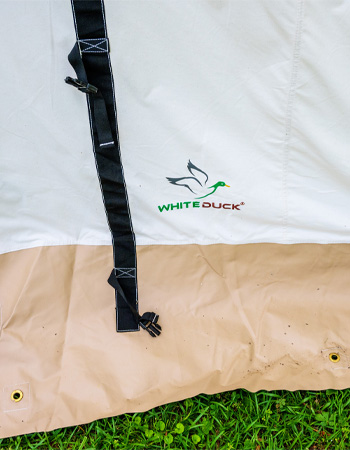
The Alpha Wall Tent arrived on my doorstep in two large, heavy boxes. One box contained the tent frame and hardware, the other the covering. The boxes, one weighing nearly 90 pounds and the other over 100 pounds, called for team lifting. My helper and I loaded them onto a garden cart and towed them to the backyard with the lawn tractor. First lesson learned: this is a base camp tent that you won’t want to tote very far by hand.
The frame poles were easy to identify, although I wouldn’t want to try it in the dark. They locked together securely with spring button connectors. After unfolding the canvas and locating the tent entrance, we had no trouble lining up the covering and sliding it over the nearly completed frame. When the canvas was positioned, we inserted the final leg poles before staking the tent down. The kit included two types of ground stakes, one type for the pole feet and another for the guy lines, and a mallet. The included mallet felt a bit undersized, so I used a heavier one.
Following the instructions that were included with the kit and available on the website, we assembled the tent in about an hour and a half. The instructions were crystal clear, but the components were thoroughly packed and wrapped for shipping. Unwrapping and sorting the parts, and the normal new tent learning curve, doubled the setup time (later in the season we set it up in just 45 minutes). It’s important to have a helper for assembly and disassembly because of the weight of the canvas.
Reliable Dry Storage, Comfortable Space For Work
For my purposes, as a combination storage shed, workshop, and office space, the 10 x 12 footprint worked out extremely well. I was able to store my portable generator, table saw and miter saw tables, saw horses, lumber, and other assorted tools and equipment, with plenty of space to spare for a folding table and chair where I could work on my laptop. Compared to wall tents supported by wooden ridge poles and uprights, the freestanding metal frame eliminated any obstructions at the entrance for a clear access pathway. The heavy duty zipper on the bug netting was another thoughtful touch. Not once did it bind up or stick when I operated the zipper: It simply worked.
One stormy afternoon the wind intensified while I was sitting at my makeshift workstation. I closed the inside window flaps and considered heading to the house to avoid damaging my laptop if the tent failed. But I didn’t have a rain jacket, and it was pouring, so I decided to ride it out and see what would happen. After two hours of winds gusting to 30 miles per hour, and 1.5 inches of rain, I am happy to report that everything stayed safe and dry inside the Alpha Wall Tent. Later, I checked the ground stakes, tent lines, and grommets for any signs of shifting, wear, or damage and found not one thing out of place. It’s nice to have another reliable option for remote work.
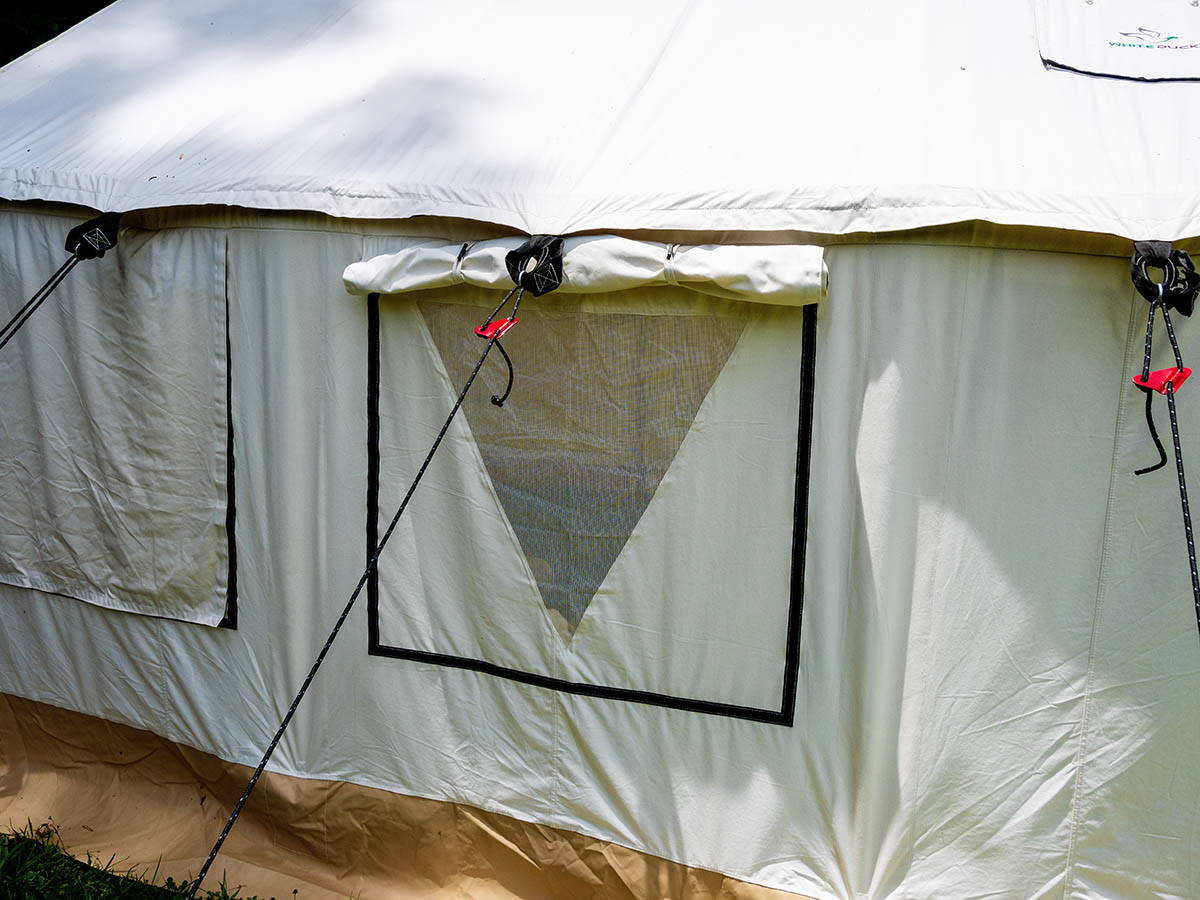
Great For Cooler Temps, Not So Much For Hot Weather
The most practical DIY applications that I found for the Alpha Wall Tent included storage, small project work, and computer work. I avoided using saws and sanders because I didn’t want to clean wood fibers off the canvas. Because my neighborhood is so quiet during the day, I could work uninterrupted for hours at a time with only the sounds of birds and breeze (and occasional rain) in the background.
But living in an area with notoriously hot summers, I went back to the house as summer temperatures set in. Even with the vent flaps open and a fan circulating the air, the tent became too hot for me to sit and write by midday. Part of that resulted from the full sun location, and part because I didn’t use a rain/shade fly over the tent (which could reduce the temperature inside by more than 10 degrees).
We waited until evening on a dry, sunny day to take down the tent. That way it would go into storage as dry as possible to prevent mildew. Two of us removed the ground stakes, lowered the frame legs on one side, pulled the cover off, folded the cover and took down the rest of the frame in about 30 minutes. Amazingly the tent cover fit back into its original canvas bag, as did the poles and tool kit. Some canvas tent owners store their tents in large plastic trash cans with lids to make them easier to transport while protecting against water and rodent damage. I stored mine in its bag on a shelf near the basement dehumidifier.

Costs More Than A Vinyl Shelter, But Worth Every Penny
Using a wall tent for a backyard workshop may seem like a bit of an eccentric choice, and it may not work for everyone. After all, vinyl sheds are similarly portable and are much cheaper. But vinyl sheds are built to store stuff, not to actually work in. A wall tent comes with more possibilities, including its original use as a place to sleep. Once assembled, it is safe to leave up for months at a time. It’s portable, infinitely more durable than a nylon tent, and cheaper than building a garage or cabin in the woods.
At around or a little under $2,000, the Alpha Wall Tent is priced about the same as many similar canvas wall tents, but is loaded with features that would cost more elsewhere, such as windows, bug screen, stove jack, floor, and heavy-duty tie-downs, plus the frame is included. It also comes in other sizes to meet your needs.
Buy the White Duck 10 x 12 Alpha Wall Tent on:
Product Comparisons
| White Duck Alpha Wall Tent | Shelter Logic Shed-In-A Box | Kodiak Canvas Cabin Lodge Tent | Guide Gear Canvas Wall Tent | Diamond Brand Atlas Wall Tent | |
| Frame | 1.81 inch tubular steel | 1.375 inch tubular steel frame | 1 inch tubular steel | NA | Sold separately(1.5 inch square steel Orion tent frame) |
| Covering | 10.1 ounce cotton duck canvas | Ripstop polyethylene | Cotton duck canvas(10 ounce roof, 8.5 ounce walls) | 10 ounce cotton canvas | 13 ounce poly cotton canvas |
| Floor | 16 ounce polyvinyl | NA | 13.5 ounce vinyl | Canvas | NA |
| Dimensions | 12 feet long 10 feet wide, 8.25 feet high | 10 feet long 10 feet wide8 feet high | 12 feet long 12 feet wide 7.5 feet high | 12 feet long 10 feet wide 8.25 feet high | 12 feet long 10 feet wide 8.83 feet high |
| Weight | 192 pounds | 90 pounds | 97 pounds | 53.3 pounds | Not provided |
| Price | $1,880.00 | $344.99 | $959.00 | $489.99 | $1,180.00 |
So, is the White Duck Alpha Wall Tent right for you?
The White Duck Alpha Wall Tent is large and sturdy for comfortable, dependable shelter in any season. The brand markets these tents for camping, but they can also fill a variety of roles at home. In the backyard, an Alpha Wall Tent could serve as a workshop, office, guest room, or sheltered outdoor dining area. If “man caves” and “she sheds” are still a thing, it could do that too. I would not use it as a wood or metalworking shop, paint booth or other work space where flying particles or chemicals are part of the equation.
The 10-by-12-foot model that I tested is about twice the size of my regular home office space. After adding a portable power station, a fan, and some office lighting, the tent worked perfectly for my office needs. I thoroughly enjoyed being closer to nature as I banged away on my keyboard, and I had an ample supply of additional space for storage and working on small projects. The sound of gentle rain on the canvas was more pleasant than electronic “white noise,” and I felt completely safe in all but the most severe storm conditions. I have not used it through winter yet, but I will consider adding a small wood stove for cold weather comfort.
Meet the Tester
Mark Wolfe is a product tester and writer with an extensive background in the nursery and landscaping industry. He kept his tool box well stocked in order to build or repair fences, walls, irrigation systems, and equipment on any given day. Now he tests and writes reviews about the latest hand tools, lawn care products, outdoor power equipment, and other outdoor living goods.

